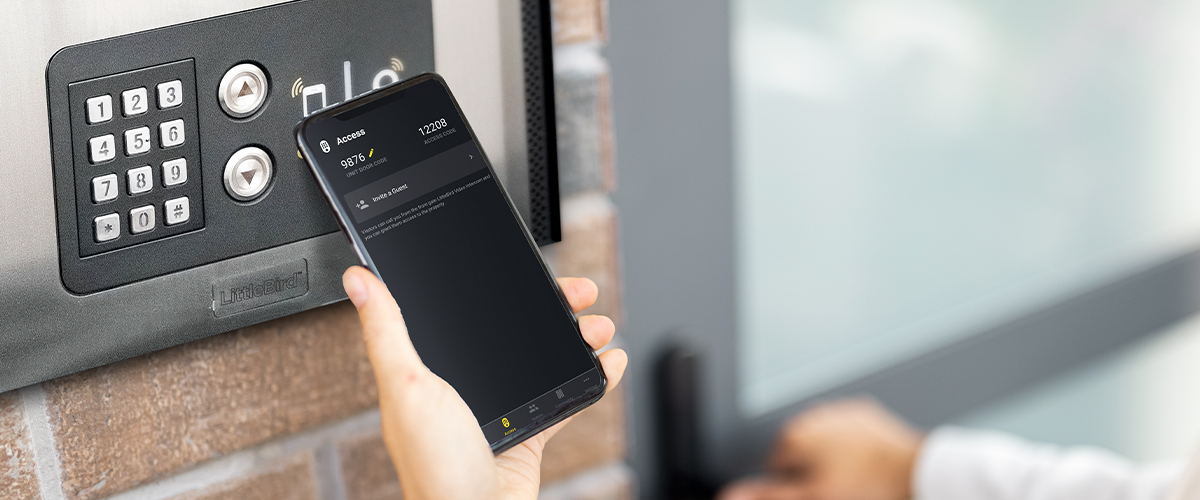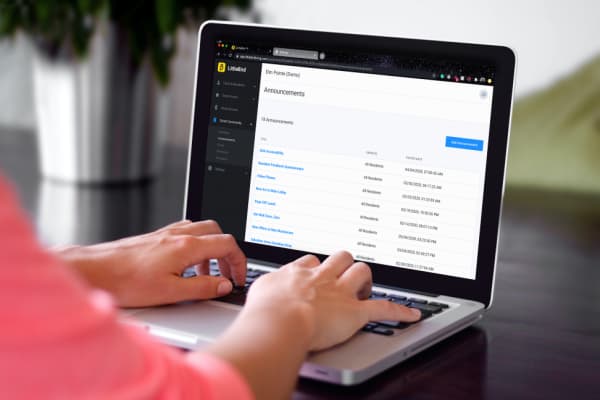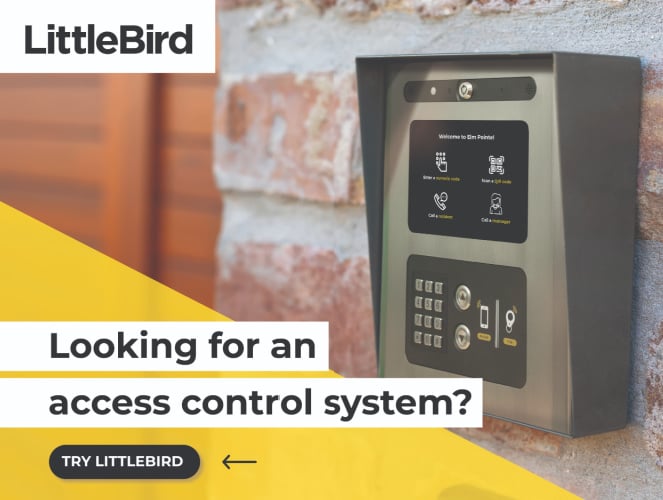The Importance of Resident Access Control: A Comprehensive Guide
As the owner or manager of a multifamily community, your residents’ safety and security are of the utmost importance. One of the key ways to ensure their safety is by managing access to the property effectively.
Not only does proper access control keep unwanted persons off the property, but it can also help reduce theft and damage, provide a full access report that shows who went through gates at various times, and save property staff time by enabling them to easily manage things through a web portal.
In this blog, we’ll discuss some of the challenges of managing access for multifamily communities and how LittleBird can help.
Navigate this article:
- What is resident access control?
- Why is managing resident access important?
- Challenges of managing resident access
- 8 ways LittleBird helps property staff manage resident access
- ROI of resident access control
What is resident access control?
Resident access control for multifamily properties refers to the process of managing and controlling access to various areas within the property, such as the building entrances, amenity areas, parking lots, and other common spaces, for the residents who live there.

It involves creating a secure and convenient system that allows residents to access the areas they need while preventing unauthorized access from outsiders.
The evolution of access control for multifamily properties
In many multifamily properties, access control is typically managed through the use of physical keys or keycards, which are issued to each resident upon move-in. However, this traditional method of access control has several drawbacks, including the potential for lost or stolen keys, the need to manually issue and manage access credentials, and the difficulty of revoking access for former residents.
To address these challenges, many multifamily property owners and managers are turning to modern access control solutions, such as cloud-based access control systems, that offer greater flexibility, convenience, and security.
These solutions leverage technology to provide a more streamlined and automated approach to managing resident access control.
Why is managing resident access important?
Resident access control is crucial for multifamily properties for several reasons including enhancing security, providing liability protection, increasing protection, increasing privacy, providing resident convenience, and cost-effectiveness.

Enhanced Security
The safety and security of residents are a top priority for any multifamily community. With access control, property managers can limit unauthorized access and monitor who is entering and exiting the premises. This can help to deter criminal activities such as theft, burglary, and vandalism.
Liability Protection
Multifamily property managers have a legal responsibility to provide a safe living environment for their residents. Access control systems can help to prevent unauthorized visitors from entering the property, which can reduce the risk of accidents or injuries that can result in lawsuits and liability claims.
Increased Privacy
Residents value their privacy and the security of their personal information. Access control systems can ensure that only authorized personnel have access to sensitive areas of the property, such as the mailroom or fitness center, and prevent unauthorized entry to individual units.
Convenience
Access control systems can make it easier for residents to access common areas such as gyms, pools, and parking garages without the need for physical keys. This can save time and provide a more seamless living experience.
Cost-Effective
With access control systems, property managers can avoid the cost of replacing physical keys and rekeying locks. Instead, they can simply revoke access to a lost or stolen keycard, fob, or mobile credential.
Overall, resident access control is an essential aspect of multifamily property management that helps to ensure the safety, security, and privacy of residents while also providing convenience and cost savings for property managers.
Challenges of Managing Resident Access for Multifamily Communities
Managing resident access control for multifamily properties can be a daunting task due to several challenges, including:
- Complex access requirements
- High resident turnover
- Security risks
- Lack of accountability
- Operational inefficiencies
- Lack of vacant unit optimization
Let’s look at each challenge closer.
1. Complex Access Requirements
Multifamily properties typically have several types of units, ranging from studio apartments to three-bedroom units. These units can have different access requirements, depending on the type of tenant and their preferences. For instance, some tenants may prefer keyless entry systems while others may prefer traditional key-based systems. Managing these complex access requirements can be time-consuming and resource-intensive.
2. High resident turnover
Multifamily properties typically have high tenant turnover rates, with tenants moving in and out of units regularly. Managing access for incoming and outgoing tenants can be challenging, particularly when dealing with traditional key-based systems. This process can involve rekeying locks and distributing new keys, which can be time-consuming and expensive.
3. Security Risks
Multifamily properties are susceptible to security risks, such as theft, vandalism, and break-ins. Traditional key-based systems can be vulnerable to these risks, particularly if keys are lost or stolen. Additionally, keys can be easily copied, making it difficult to track who has access to the property. Managing these security risks can be a significant challenge for property managers, particularly if they lack the resources and expertise to implement robust security measures.
4. Lack of Accountability
Traditional key-based systems can make it difficult to hold tenants accountable for their actions, particularly if they lend their keys to others or lose them. This lack of accountability can lead to security breaches and other issues, making it challenging for property managers to maintain a safe and secure property.
5. Operational Inefficiencies
Managing traditional key-based systems can be time-consuming and resource-intensive, particularly when dealing with large multifamily properties. For instance, property managers may need to maintain an inventory of keys, track who has access to the property, and manage key distribution and collection. These operational inefficiencies can be a significant challenge for property managers, particularly if they are already stretched thin.
6. Lack of vacant unit optimization
Managing access for multifamily communities can be a challenge when it comes to managing vacant units. Traditional access control methods do not provide an efficient way to manage access to vacant units, which can lead to energy waste and increased risk of theft and damage.
Overall, managing resident access control for multifamily properties can be a complex and challenging task. However, with the right tools and expertise, property managers can overcome these challenges and implement robust access control systems that improve security, reduce costs, and enhance tenant satisfaction.
This is where LittleBird comes in, offering a modern access control solution that helps property managers manage resident access control with ease.
8 Ways LittleBird Helps Property Staff Manage Resident Access
LittleBird helps property staff manage resident access by providing a comprehensive and user-friendly access control system specifically designed for multifamily properties.

1. Streamlined Resident Onboarding
LittleBird provides a simple and streamlined onboarding process for new residents. The property staff can easily invite residents to download the LittleBird app and set up their accounts, which includes creating a unique PIN for access to common areas and building entry. This process can be completed remotely, making the move-in day less stressful for both staff and residents.
2. Access Control for Multiple Buildings
LittleBird allows property staff to manage access control for multiple buildings from a single dashboard. This makes it easy to manage access for residents, staff, and contractors across the entire property portfolio.
3. Customizable Access Levels
LittleBird allows property staff to create customized access levels for residents, which can be based on factors such as building location, time of day, and individual resident needs.
For example, staff can set up access levels that only allow residents to access certain areas of the building during certain times of day, or that restrict access to certain areas based on a resident's lease agreement.
4. Real-Time Access Monitoring
LittleBird provides real-time monitoring of access activity across the property. Staff can view access logs, see who has accessed the building or common areas, and receive alerts for any suspicious activity. This helps staff maintain a safe and secure environment for residents.
5. Visitor and Guest Management
LittleBird’s Smart Access product includes an easy-to-use video intercom system that allows visitors to call a resident through the intercom to be granted access.
In addition, the guest management feature allows residents to send expected guests a QR code and unique numeric gate code to let them into the property when they arrive. This not only allows residents to manage access for their guests more easily but also reduces the risk of unauthorized visitors gaining access to the property.
6. Keyless Entry
LittleBird’s Smart Access product allows residents to use NFC and Bluetooth on their smartphones to unlock gates, so they don’t need physical keys. This not only eliminates the need for physical access control devices – – which can be easily lost, stolen, or shared – but also makes it easier for residents to enter the property and their units.
7. Smart Home Integration
LittleBird’s Smart Access product integrates seamlessly with the Smart Home product to provide a comprehensive resident experience. Smart locks can be seamlessly integrated with the Smart Access guest management system to allow a resident to send both a gate code and a door code to a guest.
In addition, the Smart Home product allows properties to automatically manage vacant units by turning on and off lights, setting the smart thermostat, and resetting lock codes on the smart lock.
8. Remote Management
LittleBird’s manager portal allows property staff to manage access control remotely, from anywhere with an internet connection. This means staff can easily grant or revoke access, change access levels, and monitor activity from their computer or mobile device.
Overall, LittleBird provides an intuitive and efficient solution for managing resident access control in multifamily properties. With its customizable access levels, real-time monitoring, and remote management capabilities, LittleBird can help property staff save time and increase the security of their properties.
ROI of Resident Access Control
The ROI (Return on Investment) of having resident access control for multifamily communities can be significant.
Increase rental rates
Firstly, implementing a comprehensive access control system can increase the perceived value of the property, which can lead to higher rental rates and occupancy rates. Residents are willing to pay more for properties that have secure access control measures in place.
Additionally, residents are more likely to stay longer in a property that they feel is safe and secure, reducing vacancy rates and turnover costs.
Decrease operational costs
Secondly, access control systems can help reduce the costs associated with physical keys and traditional lock changes. Property managers can remotely grant and revoke access, reducing the need for on-site staff to physically distribute and collect keys.
This also eliminates the need for costly rekeying when a resident moves out, as access can be easily disabled for that individual.
Reduced theft and damages
Thirdly, access control systems can help reduce the risk of unauthorized entry and theft, reducing the likelihood of damage to the property and the costs associated with repairs and replacements. In the event of a security breach, access control systems can provide valuable evidence to aid in investigations.
Saves property staff time
Lastly, access control systems can also help reduce the workload of property staff, freeing up time for other tasks. Remote access control management allows property managers to monitor and control access from anywhere, reducing the need for on-site staff to constantly monitor access.
Overall, the ROI of implementing resident access control can be significant in terms of increased property value, reduced operating costs, improved security, and increased efficiency for property staff.
In summary...
- Resident access control involves managing access to various areas of a multifamily property to allow residents in while preventing unauthorized access from outsiders.
- Modern access control solutions like cloud-based access control systems offer greater flexibility, convenience, and security than traditional methods like physical keys or keycards.
- Managing resident access control is crucial for multifamily properties as it enhances security, provides liability protection, increases privacy, provides convenience, and is cost-effective.
- Managing resident access control for multifamily communities can be challenging due to complex access requirements, high tenant turnover rates, security risks, lack of accountability, operational inefficiencies, and lack of vacant unit optimization.
- Access control solutions can provide a more streamlined and automated approach to managing resident access control and can be used to monitor who is entering and exiting the premises to deter criminal activities like theft, burglary, and vandalism.
-1.png?width=5935&height=1114&name=NEW%20LU%20%E2%80%93%20Long%20Logo%20%E2%80%93%20Dark%20(1)-1.png)

Comments